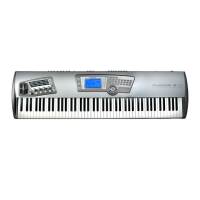4
Chapter 4: Advanced Features
216
Menu: (various modes)/Arp/Edit Arp/Setup
Parameter: Arp Only
Value Range: On, Off
If you want only your arpeggiation pattern to sound when you press a
key (or chord), check this box. If you leave this box unchecked, you’ll
hear both the arpeggiation pattern as well as the underlying note (or
chord) that you play. This is true regardless of the setting of the
“Playback Mode” parameter.
Menu: (various modes)/Arp/Edit Arp/Setup
Parameter: Latch Type
Value Range: Off, Latch, Mask
“Latching” is a method of letting your arpeggiation play without having
to hold down any notes (or trigger sources). This is useful because it
frees up your hands to do other things in a performance (twiddle knobs,
play other keyboards or instruments, etc.). The Fusion has two different
modes of latching that are explained below. Note that latching does not
take place until it is actually engaged using the modulation route (see
below).
Latch: This mode simply plays your arpeggiation pattern
based on what you have played (either a single note or a
chord) and continues to play until you turn latching off.
Mask: This mode lets your arpeggiation pattern run silently in
the background and only makes sound when you press
a key (or chord). This is useful if you want to accent
certain parts of your arpeggiation pattern while leaving
other parts silent.
Menu: (various modes)/Arp/Edit Arp/Setup
Parameter: Change A/B on Fill
Value Range: On, Off
This parameter automatically shifts your arpeggiation variation from “A
Fill” to “B” and from “B Fill” to “A” once you reach the end of the fill.
Menu: (various modes)/Arp/Edit Arp/Setup
Parameter: A/B Change
Value Range: Now, Measure 1, Measure 2, Measure 3 and Measure 4
This parameter determines how quickly the shift between variation “A”
and “B” take place. Set this parameter to “Now” if you want the change
to be immediate (no fill will be played). If you want the changeover to
take place after the end of the first, second, third, or fourth measure, set
this parameter accordingly.

